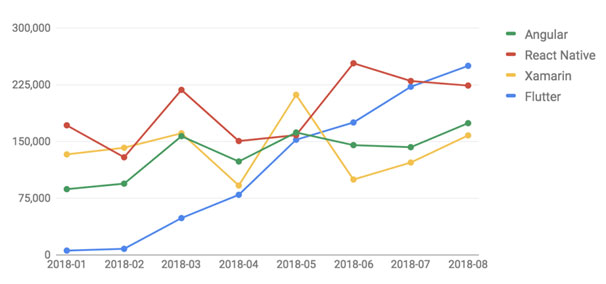Best cross-platform app development frameworks in 2022
In today's tech-friendly generation, cross-platform applications have become popular due to lesser efforts for application development on multiple platforms. These applications offer wider audience reach and synchronized updates, for which they are quite in demand.
Now, to create a high-end cross-platform application, you need a good cross-platform application development framework. Such frameworks help to create a cross-platform application from scratch and ensure its better efficiency.
So, which cross-platform app development frameworks are the best? Our tech-geeks did some thorough research to find out the best-in-class frameworks of all time. Here's their pick:
React native
React Native is one of the best cross-platform application development frameworks built on programming languages like JavaScript. It helps you to create native apps for both Android and iOS simultaneously. The best feature of React Native is that it allows you to create applications for different platforms with the same base code. It's also popular for its third-party integrations, reusable components, and cost-efficiency.
Besides that, it empowers front-end developers with faster deployment and development. Thanks to its exclusive features, React Native has become a trustworthy framework for popular brands like Tesla, Skype, and Airbnb.
Pros
- Highly responsive UI
- Helpful and comprehensive libraries
- Community-driven for developer support
- Live reload
- Flexible framework
Ionic
Ionic is an open-source mobile toolkit that's useful for creating high-end cross-platform native/web applications. It offers different mobile-optimized UI components, gestures, and tools for creating fast and interactive applications. Ionic is based on two main components, i.e., Apache Cordova and one of the top development frameworks like Angular.JS
One of the best things about Ionic is that its components are written in CSS, HTML, and JavaScript. With these simple UI components, it's easier to build high-quality UIs offering greater performance. It also offers 120 native device plugins to access Camera, Bluetooth, Geolocation, etc.
Pros
- Flexible and developer-friendly
- Multiple choices for UI components
- Based on one code
- Well-equipped with tools and native comparability
- Trusted by popular brands like McDonald's, Sworkit, and Nationwide.
Xamarin
Xamarin is a free, open-source, cross-platform application development framework that's used for creating Android/iOS/Windows applications with .NET and C#. It allows developers to access a full spectrum of functionalities to create applications perfect for native performance. A unique feature of Xamarin is that it allows you to use only about 90% of the code for creating applications.
It also offers powerful tools and libraries to access 2D graphics and native APIs through shared code. You can save time and cost for application development through its WORA (Write Once, Run Anywhere) support. As of 2021, Xamarin is used by 11% of software developers worldwide.
Pros
- Outstanding user interface and user experience
- Shared application code
- Access to platform-SDKs
- Allows code sharing across multiple platforms
- Strong compile-time checking
Node.JS
From Netflix to LinkedIn, Node.JS is a framework used by some of the most popular brands worldwide. It is an open-source, cross-platform, backend JavaScript runtime environment that works on a V8 engine. Node.JS helps to develop scalable and server-side networking applications. It builds efficient and responsive applications using a high-end library of various JavaScript modules.
Note that the Node.JS APIs are asynchronous. They are non-blocking in nature and do not wait for API data. This means they move to another API after calling the same. Node.JS comes with a notification server that helps the server to get a response from the prior API call.
Pros
- Faster development and efficiency
- Reusable code
- Easy to use and high-end performance
- Better application response
- Can handle multiple requests
PhoneGap/Apache cordova
PhoneGap is an outstanding cross-platform framework that uses CSS, JavaScript, and HTML5. It's secured with a single code base that helps to make applications for iOS, Android, and Windows. The framework also supports in-built device features like GPS, camera, Phonebook, storage, etc.
One of the best features of PhoneGap is its plugins and third-party app management tools that help to deliver a native app-like experience. It also comes with a cloud solution feature where developers can share the application with fellow developers during development for quick feedback. All in all, it's power-packed with scalable features for swift cross-platform app development. nall
Pros
- Open source and robust backend
- Doesn't require you to learn complex languages
- Plugin architecture
- Tons of libraries
Flutter
Introduced by Google, Flutter allows you to build high-end applications for any screen. It helps to create beautiful, multi-platform, and natively compiled applications from one codebase. It's also the most popular cross-platform mobile framework used by global developers, as per a 2021 survey.
One of the best attributes of Flutter is its portable GPU that offers UI power to work on the current interfaces. It also offers other benefits like reduced code development times, a myriad of widgets, and a powerful tech community.
Thanks to its features like an in-built graphic engine, you wouldn't have to worry about creating separate interfaces for iOS and Android. Combine this framework with a viable mobile app idea, and you are good to go!
Pros
- Hot reload feature for fast testing
- Simple user interface
- Codebase sharing
- Cost-efficient and Native performance
Conclusion
Our experts believe that these six frameworks are perfect choices for cross-platform app development. They are user-friendly, feature-rich, and practical for developers. Make sure to read through the features and details of these frameworks to find out the one that fits your requirement!



















